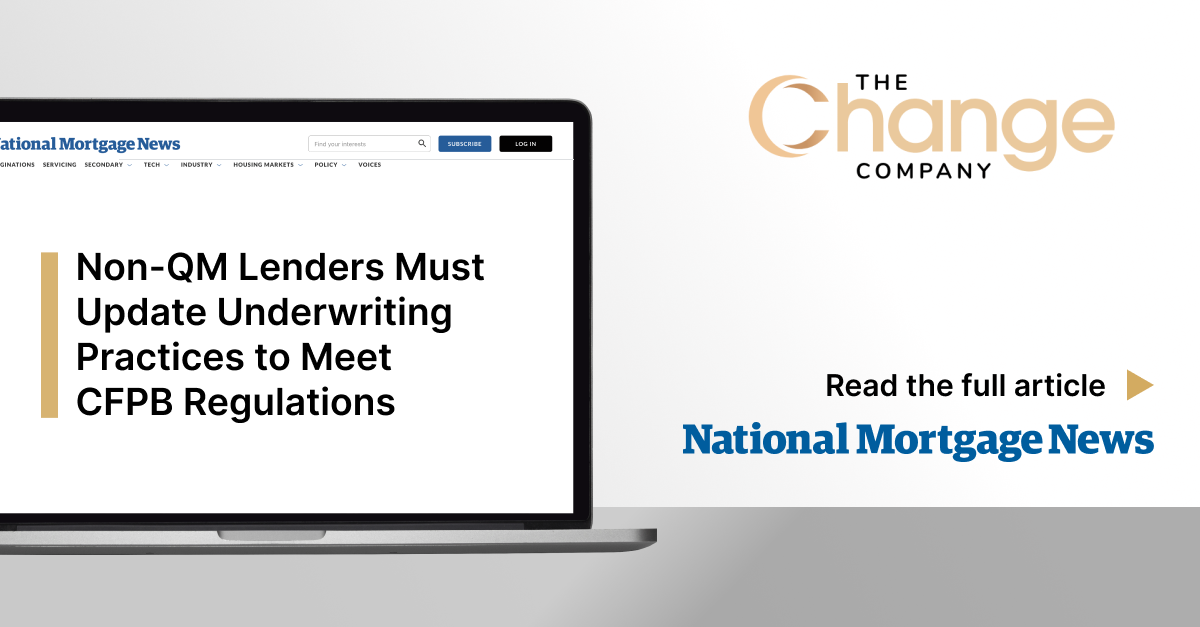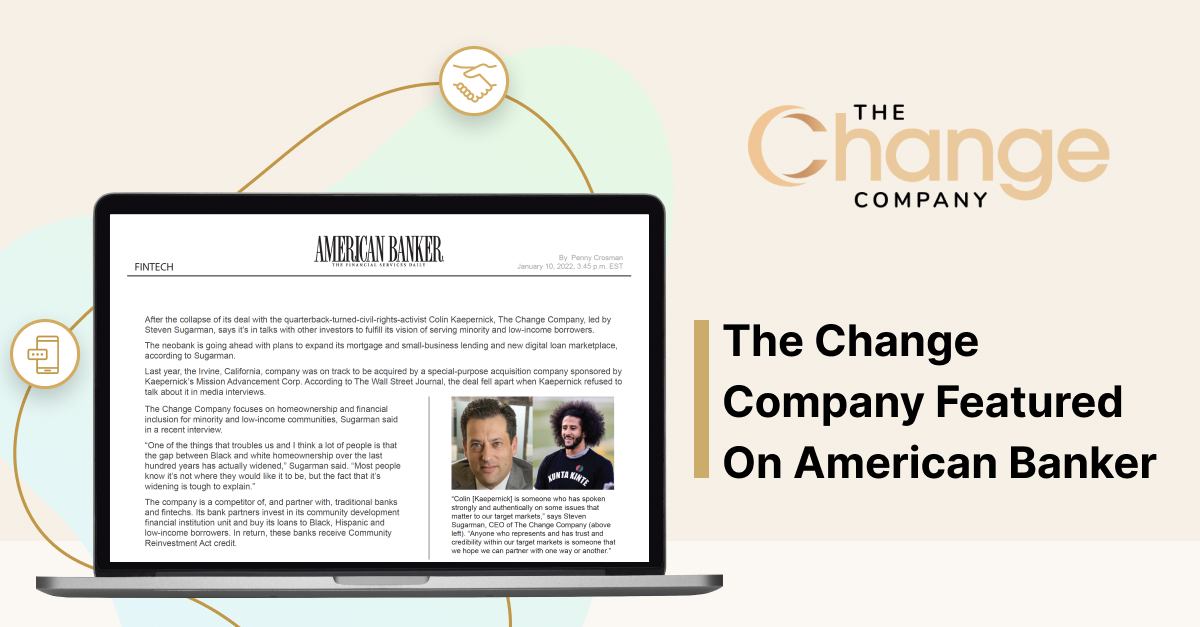This Little-Known U.S. Agency Determines Millions in ESG Investing. It’s About to Change the Rules

Lenders have rushed to earn CDFI status, the closest thing to a socially conscious seal of approval from the U.S. government. Now, the industry is pushing back on reforms.
Change Lending says it has an edge over its competitors: It can provide mortgages to borrowers who can’t document that they have the income or job security to pay those loans back.
Change says it offers this “unfair advantage” by virtue of being a Community Development Financial Institution, a little-known program under the U.S. Treasury that certifies businesses that lend to underserved communities.
Lenders have rushed to apply for CDFI certifications because it brings them major advantages, both strategic and symbolic. CDFI status is the closest thing to a socially conscious seal of approval from the U.S. government, conferring big financial advantages to small firms that otherwise fall under the radar of Wall Street. The certification can mean millions in new investment.
Other CDFIs include a used-auto chain that repossesses a fifth of the cars it sells, and a publicly traded personal-loan firm that’s under federal investigation for its debt-collection tactics.
After five years of fitful efforts, the Treasury agency that confers CDFI status—the CDFI Fund—has entered the final stages of adjusting the program’s guidelines in hopes of stemming activity by participants that some fear may undermine its mission of uplifting underserved groups.
The fund has temporarily stopped accepting new applications for the program while it reviews responses to a near-final draft of proposed rules that it published in the fall.
The revised criteria, which include caps on lending rates and strengthened underwriting rules, are expected to be in place when it resumes taking applications in April.
Some companies that may be affected by these changes are pushing back. Change, for one, has begun an advocacy campaign aimed at reversing some of the newly proposed criteria.
And the CDFI world’s main voice in Washington, D.C., has relaxed its earlier calls for strict guidelines and instead is now calling on the CDFI Fund to allow program participants more flexibility in meeting proposed new standards than permitted in the most recently released draft.
“I can’t imagine a scenario where it carries the day,” says Steven Sugarman, founder of Change, which bills itself as the nation’s largest CDFI mortgage lender. “Someone is going to look at this, and they’re going to say, ‘Let’s take a little bit more of a nuanced view here.’ ”
When the CDFI program was established by Congress in 1994,backers saw it as a way of using small community banks and non profit lenders to increase the flow of capital to low-income neighborhoods and underserved minority groups.
As of December, there were nearly 1,400 CDFIs, according to the CDFI Fund. Most are nonprofit lenders, credit unions, and small community banks, but some for-profit financial firms have been certified under the program, too.
CDFIs are eligible for limited pools of government grant money. The benefits also flow from the private market via banks that are required, under the 1960s Community Reinvestment Act, to invest in low- to moderate-income communities.
Banks can meet these requirements by lending to or investing in CDFIs, which, in turn, get lower borrowing costs compared with other sources of capital, like private-equity firms. CDFI status also has become a draw for investors and fund managers that have environmental, social, and governance, or ESG, objectives.
"We have to protect the brand because the work is really important. And part of protecting the brand is being able to filter out people who aren’t doing the right thing.”
— Annie Donovan, former director, CDFI Fund
Leaders of CDFIs and other backers of the program say it has been a lifeline for needy communities. But over the past decade, growing numbers of community banks and lenders have grown concerned that businesses were getting certified as CDFIs to gain reputational perks and access to bank loans without having at heart the welfare of the communities they purport to serve.
In 2017, the CDFI Fund took its first step toward revising its certification criteria by collecting suggestions on potential changes from CDFI leaders and others with stakes in the program.
“We have to protect the brand because the work is really important, ”says Annie Donovan, who was the CDFI Fund’s director when the changes were first being discussed and now leads a CDFI focused on Latino communities. “And part of protecting the brand is being able to filter out people who aren’t doing the right thing.”
Five years later, those revisions are still working their way through the system, even as the CDFI Fund continued to certify new businesses for much of that time.
The initial 2017 feedback was reflected in a revised draft application that the CDFI Fund circulated in 2020 to solicit further public comment. This process, which was slowed by the corona virus pandemic, resulted in the proposed changes released for a final round of public comment in November.
“With unprecedented levels of resources being directed at CDFIs, the proposed changes to the CDFI certification application deliberately set high standards,” the agency said in an update on its website in October, shortly before the new proposed updates were released.
“The revised CDFI certification application may require some CDFIs to adjust how they do business,” it said. “Some may no longer be able to meet the tests required for certification.”
CDFI Fund officials declined interview requests.
When the first draft of the proposed criteria changes were released in2020, one company, in particular, caught the attention of the Center for Responsible Lending. The group noted that personal-loan provider Fig Loans was advertising interest rates of nearly 200% on its website.
“There is no universe in which an entity charging 190% should have the imprimatur of the CDFI Fund,” the nonprofit wrote in a comment letter that it submitted to the CDFI Fund.
Under the latest draft of the changes, lending rates above 36% would trigger additional scrutiny and potential removal from the program. One change bars such lenders if more than 5% of those high-interest loans default over a 12-month period.
But there’s debate, even among CDFI advocates, on how far the new changes should go.
The CDFI Coalition, which bills itself on its website as “the unified national voice of Community Development Financial Institutions,” is pushing back.
“A strict 5% ceiling for loan product defaults could leave CDFIs at the mercy of macroeconomic forces beyond their control,” the group wrote in a comment letter this month in response to the latest draft of changes.
Bob Rapoza, whose lobbying firm, Rapoza Associates, manages the CDFI Coalition, declined to comment on the proposed criteria changes, saying the group was busy with its congressional advocacy work.
Members of Fig’s leadership did not respond to messages from Barron’s.
Jeff Zhou, a Fig co-founder, told the New York Times in 2018 that he founded Fig to give borrowers with poor credit an alternative to payday loans, which are even more expensive.
Fig was certified as a CDFI the following year, describing itself in a press release as the first “fintech,” or financial-technology firm, to be granted that status.
“As a CDFI, Fig can help banks fulfill their obligation to provide capital to underserved communities through the Community Reinvestment Act,” it said.
Before Fig’s CDFI certification, it had raised less than $3 million in venture-capital funding, according to data compiled by Pitch Book. It has since raised at least $30 million, according to an August 2020announcement of its latest funding round.
Another Texas-based business, Tricolor Auto Group, became a CDFI n 2019 on the basis of the in-house financing it offers to low- and moderate-income Hispanic buyers, who don’t have the savings, income, or credit scores to qualify for conventional loans.
In its comment letter to the CDFI Fund pushing for reform, the Center for Responsible Lending says Tricolor and other CDFIs need to go further toward confirming that borrowers can pay back loans while still meeting living expenses.
If you want to originate loans with zero risk of default, then you’re limited to super prime borrowers. That doesn’t drive financial inclusion in America.”
— Daniel Chu, CEO, Tricolor Auto Group
The nonprofit group pointed to reporting by Barron’s that showed a fifth of Tricolor’s car sales over a recent five-year period in Texas involved vehicles that it had sold in the state at least once before.
This frequency of resales, the group said, suggests that “Tricolor maybe making unaffordable loans, repossessing vehicles upon default, and selling those vehicles again.”
Chu says his company uses proprietary software to price loans it makes for cars on its lots without going through a conventional underwriting process. Many of the cars that it resold were voluntarily surrendered by buyers who didn’t want them anymore, not forcefully repossessed, he says.
“If you want to originate loans with zero risk of default, then you’re limited to super prime borrowers. That doesn’t drive financial inclusion in America,” Chu says. “The suggestion that Tricolor originates loans that are unaffordable simply ignores the realities of financing consumers with no bureau data and very low incomes.”
The Center for Responsible Lending also questions the underwriting standards of personal-loan firm Oportun, one of the few CDFIs that’s publicly traded on a stock exchange.
Oportun has attracted scrutiny from another federal agency, the Consumer Financial Protection Bureau. The company disclosed in its latest quarterly filing that the CFPB was considering legal action over its treatment of borrowers facing hardships during the corona virus pandemic and its alleged “failure to timely dismiss certain lawsuits.”
Oportun has disputed the allegations, it said in the filing.
“Oportun verifies the income of every loan applicant, and we fully underwrite every loan, in alignment with best-in-class consumer protection standards,” Oportun spokesman Usher Lieberman said in an email. He declined to comment on interactions with the CFPB.
The agency declined to comment.
In its comment letter to the CDFI Fund in 2020, the CDFI Coalition said that lending “based on a borrower’s ability to repay” should be a “minimum standard” for CDFI certification.
The group’s remarks this month were more equivocal. “We support the CDFI Fund’s effort to thwart abusive actors from obtaining CDFI certification,” it wrote. But “some coalition members saw the [ability to repay] requirement as too narrow and are concerned it will fail to capture the wide variety of credit products and individual circumstances that responsibly meet the needs of borrowers.”
The CDFI Coalition also changed its view about a proposal that would force CDFI mortgage lenders to follow consumer-protection rules from which they are now largely exempt.
These rules, enacted as part of the Dodd-Frank reforms in 2010, and implemented by the Consumer Financial Protection Bureau, spell outa specific set of documents that mortgage lenders need to verify a borrower’s ability to repay. The verification process includes asking for income, assets, employment, credit history, and monthly expenses.
The CFPB relaxed its rules in 2014 to exempt CDFIs from those regulations, under the premise that they would curtail the ability of those carefully vetted, community-focused organizations from meeting the lending needs of their low- and middle-income clients.
Since then, some bigger lenders have become certified as CDFIs, and have used the ability-to-repay rule exemption as a selling point.
Anaheim, Calif.–based Change Lending, for example, highlights the exemption in advertorial columns pitching its loans to brokers that it placed this year in National Mortgage News.
It touts the exemptions in one, from June, as an “avenue for brokers to gain an unfair advantage in today’s highly competitive market.”
“Borrowers can get approved for a loan without showing income or employment,” wrote Jon Irvine, chief production officer for Change’s wholesale-lending arm, in the column. “They can even get approved with just the first page of their bank statement.”
So far this year, some $2 billion in Change loans that aren’t bound by the “ability to repay” rule have been packaged into securities for sale to investors, says Change’s Sugarman.
They are among the first such loans to be securitized since the passage of Dodd-Frank, according to a report called “CDFIs and the Return of the ‘No-Doc’ Loan” that the Kroll Bond Rating Agency published in May.
Another CDFI, Gilbert, Ariz.–based Champions Funding, also cites its ability-to-repay rule exemption in a prospectus for brokers on its website. Its loans do not appear to have been securitized. A Champions Funding spokesperson had no comment on the proposed criteria changes.
Under the proposed changes to the CDFI’s application criteria, lenders who fail to verify the incomes of their mortgage borrowers would be barred from the program, effectively undoing their exemption from ability-to-repay guidelines.
Other proposed changes would prohibit certified lenders from originating mortgages with characteristics such as interest-only repayment periods that Dodd-Frank reforms labeled as being particularly risky for borrowers.
Sugarman says the CDFI Fund would be overstepping its authority if the criteria revisions were to be implemented as currently proposed, since that would interfere with CFPB’s jurisdiction as the nation’s chief consumer-protection agency.
The CFPB had been fulfilling an obligation to protect under privileged consumers when it exempted CDFIs from the Dodd-Frank ability-to repay rules, Sugarman says.
A CFPB spokesman declined to comment on Sugarman’s characterization.
Sugarman also says that his company’s commitment as a CDFI to serving minority borrowers would be undermined by the proposed ban on mortgages with interest-only repayment periods.
Banks and other mainstream lenders routinely offer such mortgages to home buyers whose high credit scores or big down payments classify them as low-risk borrowers, but often they fail to reach minority borrowers, he says.
“We believe that a qualified Black and Latino borrower and low income borrower—that’s 72% of our borrowers—deserve the same access to credit and the same breadth of credit products as everyone else,” Sugarman says.
In 2020, the CDFI Coalition characterized mortgage lenders’ adherence to most Dodd-Frank mortgage requirements as “baseline standards” for certification.
This month, though, it expressed support for CDFIs’ ability to “offer a variety of responsive products to their customers that do not meet these standards.”
The change in views reflects a continued debate within the CDFI community about just how far new reforms should go.
Marisa Calderon, community finance chief with the Washington, D.C.–based National Community Reinvestment Coalition and leader of its affiliated CDFI, says the CDFI Fund is right to take steps against lenders misusing its certification.
“They offer mortgage products that are remarkably similar to products that we saw prior to the housing crisis,” says Calderon. “I feel like we’ve seen this story before.”



.jpg)



.jpg)
















.png)














.jpeg)






























%2525201%252520(1).png)




